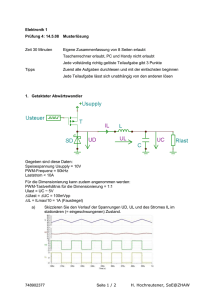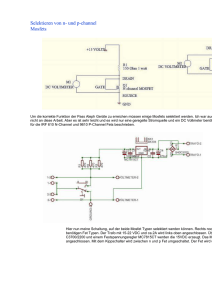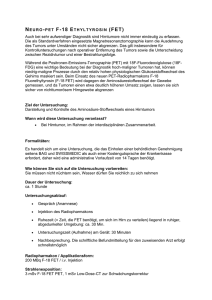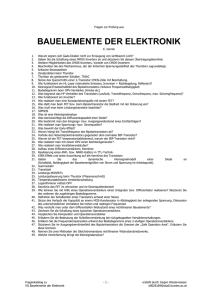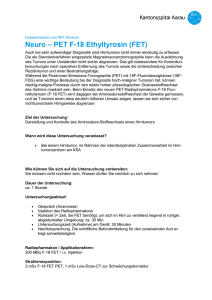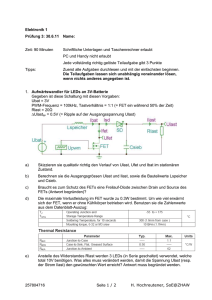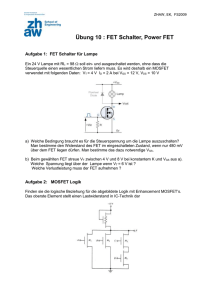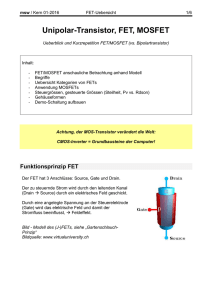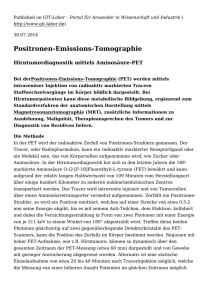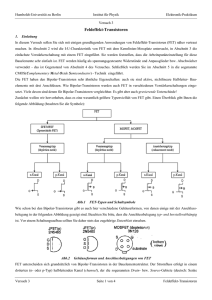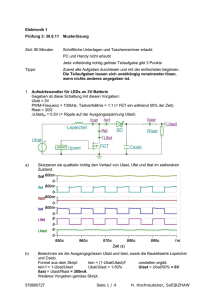(Auszug aus dem Jahresbericht 2010) [ PDF
Werbung
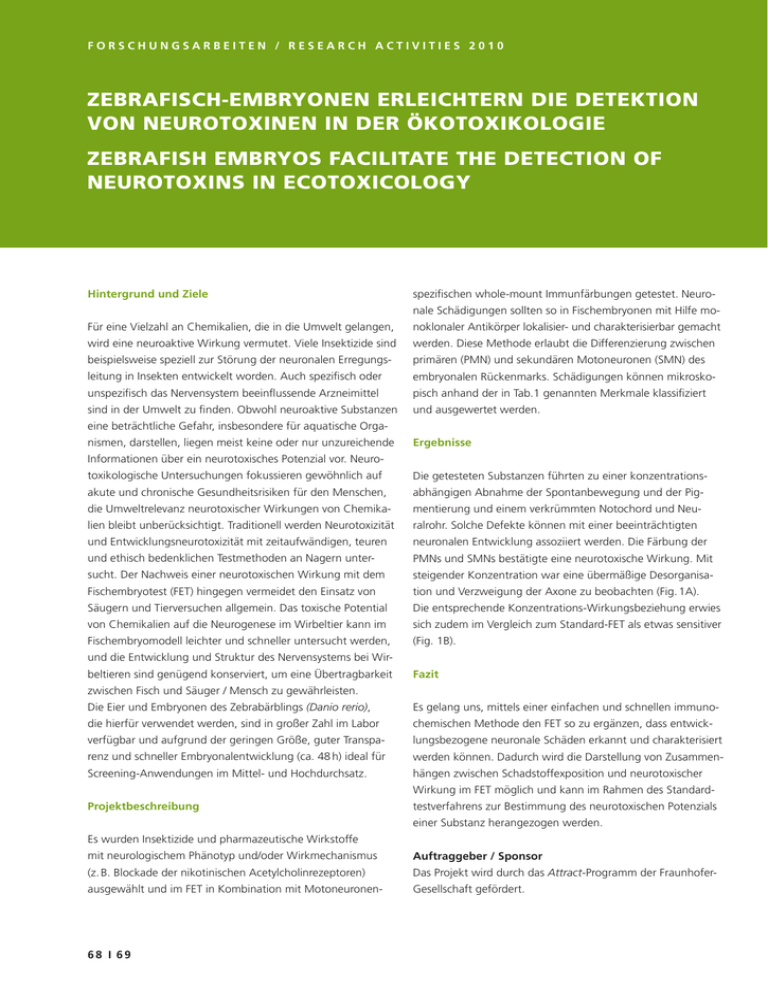
F o r s c h u n g s a r b e i t e n / R e s e a r c h A c t ivi t i e s 2 0 1 0 ZEBRAFISCH-EMBRYONEN ERLEICHTERN DIE DETEKTION VON NEUROTOXINEN IN DER ÖKOTOXIKOLOGIE ZEBRAFISH EMBRYOS FACILITATE THE DETECTION OF NEUROTOXINS IN ECOTOXICOLOGY Hintergrund und Ziele spezifischen whole-mount Immunfärbungen getestet. Neuronale Schädigungen sollten so in Fischembryonen mit Hilfe mo- Für eine Vielzahl an Chemikalien, die in die Umwelt gelangen, noklonaler Antikörper lokalisier- und charakterisierbar gemacht wird eine neuroaktive Wirkung vermutet. Viele Insektizide sind werden. Diese Methode erlaubt die Differenzierung zwischen beispielsweise speziell zur Störung der neuronalen Erregungs- primären (PMN) und sekundären Motoneuronen (SMN) des leitung in Insekten entwickelt worden. Auch spezifisch oder embryonalen Rückenmarks. Schädigungen können mikrosko- unspezifisch das Nervensystem beeinflussende Arzneimittel pisch anhand der in Tab.1 genannten Merkmale klassifiziert sind in der Umwelt zu finden. Obwohl neuroaktive Substanzen und ausgewertet werden. eine beträchtliche Gefahr, insbesondere für aquatische Organismen, darstellen, liegen meist keine oder nur unzureichende Ergebnisse Informationen über ein neurotoxisches Potenzial vor. Neurotoxikologische Untersuchungen fokussieren gewöhnlich auf Die getesteten Substanzen führten zu einer konzentrations- akute und chronische Gesundheitsrisiken für den Menschen, abhängigen Abnahme der Spontanbewegung und der Pig- die Umweltrelevanz neurotoxischer Wirkungen von Chemika- mentierung und einem verkrümmten Notochord und Neu- lien bleibt unberücksichtigt. Traditionell werden Neurotoxizität ralrohr. Solche Defekte können mit einer beeinträchtigten und Entwicklungsneurotoxizität mit zeitaufwändigen, teuren neuronalen Entwicklung assoziiert werden. Die Färbung der und ethisch bedenklichen Testmethoden an Nagern unter- PMNs und SMNs bestätigte eine neurotoxische Wirkung. Mit sucht. Der Nachweis einer neurotoxischen Wirkung mit dem steigender Konzentration war eine übermäßige Desorganisa- Fischembryotest (FET) hingegen vermeidet den Einsatz von tion und Verzweigung der Axone zu beobachten (Fig. 1A). Säugern und Tierversuchen allgemein. Das toxische Potential Die entsprechende Konzentrations-Wirkungsbeziehung erwies von Chemikalien auf die Neurogenese im Wirbeltier kann im sich zudem im Vergleich zum Standard-FET als etwas sensitiver Fischembryomodell leichter und schneller untersucht werden, (Fig. 1B). und die Entwicklung und Struktur des Nervensystems bei Wirbeltieren sind genügend konserviert, um eine Übertragbarkeit Fazit zwischen Fisch und Säuger / Mensch zu gewährleisten. Die Eier und Embryonen des Zebrabärblings (Danio rerio), Es gelang uns, mittels einer einfachen und schnellen immuno- die hierfür verwendet werden, sind in großer Zahl im Labor chemischen Methode den FET so zu ergänzen, dass entwick- verfügbar und aufgrund der geringen Größe, guter Transpa- lungsbezogene neuronale Schäden erkannt und charakterisiert renz und schneller Embryonalentwicklung (ca. 48 h) ideal für werden können. Dadurch wird die Darstellung von Zusammen- Screening-Anwendungen im Mittel- und Hochdurchsatz. hängen zwischen Schadstoffexposition und neurotoxischer Wirkung im FET möglich und kann im Rahmen des Standard- Projektbeschreibung testverfahrens zur Bestimmung des neurotoxischen Potenzials einer Substanz herangezogen werden. Es wurden Insektizide und pharmazeutische Wirkstoffe mit neurologischem Phänotyp und/oder Wirkmechanismus Auftraggeber / Sponsor (z. B. Blockade der nikotinischen Acetylcholinrezeptoren) Das Projekt wird durch das Attract-Programm der Fraunhofer- ausgewählt und im FET in Kombination mit Motoneuronen- Gesellschaft gefördert. 68 I 69 Figure 1: Effects of thiocyclam on primary and secondary motor axon development. (A) Notochord of embryos stained with znp1 for PMNs or zn8 for SMNs. (B) Comparison of concentration-effect curves of standard zFET and neurotoxicity tests. Antibodies were supplied by the Developmental Studies A B F2 Hybridoma Bank, Iowa. Background and aims Results Many chemicals entering the environment are likely to be The substances we tested induced a concentration-dependent neuroactive. For example, many insecticides are developed reduction in spontaneous movement and pigmentation, as specifically to disrupt neuronal transmission in insects. well as malformation of the notochord and neural tube. Such Pharmaceuticals that specifically or non-specifically target the defects are often associated with neurodevelopmental aberra- nervous system are also detected in the environment. Despite tions. Specific staining of the PMNs and SMNs confirmed the the considerable hazard these neuroactive substances may neurotoxic effects. With increasing concentrations, excessive cause to aquatic organisms, there is generally little or no in- branching and disorganisation of the axons became apparent formation about their neurotoxic potency. Neurotoxicological (Fig. 1A). Furthermore, the corresponding concentration-effect studies commonly focus on acute and chronic human health relationship turned out to be more sensitive than the standard risks only, whereas the environmental relevance of neurotoxic FET (Fig. 1B). effects is generally ignored. Traditionally, developmental neurotoxicity is assessed in rodents, using expensive, time- Table 1: Classification of motor axon defects observed in 48 hours consuming and ethically disputable test methods. The use post fertilization zebrafish embryos of animals for the detection of neurotoxic effects can be avoided by applying the fish embryo test (FET) instead. The fish embryo model allows the neurotoxicity of chemicals to be tested rapidly, and there is sufficient conservation in the vertebrate nervous system to provide transferability between Motor axon defect Truncated at the horizontal myoseptum Truncated at the horizontal myoseptum + excessively branched Excessively branched but not truncated Innervates neighboring myotome Ectopic branches or ventral roots but overall normal axon morphology Defasciculated axons Classification Severe Severe Moderate Moderate Mild Mild fish, non-primate mammals and humans. Zebrafish (Danio rerio) eggs and embryos are readily available in large numbers Conclusion for laboratory tests, and due to their small size, transparency and rapid development (~48 h), they are ideal for medium/ We were able to refine the FET by adding a rapid and conve- high throughput screening applications. nient immunochemical method that facilitated the detection and characterization of neurodevelopmental defects. This Approach allowed us to correlate contaminant exposure with neurotoxic effects in the FET, and can be used simply in the context of the Several pesticides and pharmaceuticals with neurological standard test procedure to determine the neurotoxic potential effects and/or mode of action (e. g. inhibition of nicotinic of any substance. acetylcholine receptors) were selected and tested in the FET combined with motor neuron-specific whole mount Contact / Ansprechpartner immunostaining. Monoclonal antibodies were used to Dr. Martina Fenske localize and characterize neuronal damage in fish embryos. Tel: +49 241 6085 - 12230 This method allowed primary motor neurons (PMN) and [email protected] secondary motor neurons (SMN) in the embryonic spinal cord to be distinguished. Defects were classified micro- Dr. Elke Muth-Köhne scopically as shown in Table 1. Tel: +49 241 6085 - 11411 [email protected]
